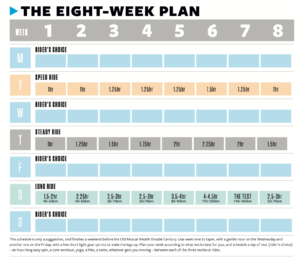Your 8-Week Old Mutual Wealth Double Century Training Plan
With just 3 rides a week – one long, one steady, and one speedy – this plan will have you ready to ride when you line up in Swellendam.
There’s a kind of magic that comes from watching a bike computer tick over to a new personal-best distance. Watching your plan come together. It’s a mileage with gravity, an accomplishment of significance. A challenge that doesn’t necessarily turn you inside out. And yet, if you need a full day on the bike to work through some dark stuff, and emerge drained and hopeful on the other side, a bike adventure can do that too. Somewhere in that number, there are hours of joy, effort, and exhaustion, along with a sense of bucket-list satisfaction that your legs can carry you further than maybe you thought even possible, under their own power.
Signing up for the Old Mutual Wealth Double Century and riding what seems like too far to most non-cyclists is a goal well worth celebrating. But first you’ll want to consider actually training for it!
The Old Mutual Wealth Double Century ‘only’ has a few thousand metres of climbing over 200-plus kilometres, most of which comes in the two Tradouw passes; so tailor your ride time and routes to get used to flatter, faster rides too. This can be a huge factor in ride-day success – so include enough hills in your ride lead-up, but don’t forget to focus appropriately on training with your team on flatter, faster routes, or you could well end up destroying your DC dreams on the terrain you least expect.
As with all endurance training plans, this one is based on time, not distance, due to the effects of weather and elevation – because 20km into a headwind, or with a long draggy climb, is very different from 20km of tailwind or flowing descent. So a training plan could include ‘Ride for 90 minutes in zone 2.’ The distance may well vary, but the training volume can be ascertained.
For the first 80-90km, if it feels too slow, it’s probably about right.
This eight-week programme from long-time Bicycling guru and endurance maven Selene Yeager, to which you should add a day for stretching and core work, a day off, and maybe another (gentle) long ride, if you have the time – all while keeping an eye on your nutrition and sleep, will get most of us to the start line ready to rumble.
The most important thing you can work on is getting used to the feel of metering effort all day, and never riding into the red or at threshold-effort level. On a rate-of-perceived-exertion (RPE) scale of one to 10, the DC should be ridden at a three to four, or possibly a five to six if you feel you can sustain that. For the first 80-90km, if it feels too slow, it’s probably about right.
Save your heroic efforts for when you’re near the finish. Your technique and posture will fall apart, and you’ll probably go to what Page-Hanson calls “a dark place”. “Only light your fireworks when you see the finish line.”
The Rides on Your DC Training Plan
Long Ride: The Meat
In your first week you’ll want to ride 1.5 to 2 hours, or about 35km, and build from there. If you’re already comfortable with a longer ride than week 1 prescribes, start with 2.5 to 3 hours and follow the same guidelines for mileage building, topping off at about 130km.
Do your long rides at a steady-but-not-taxing pace – about 70 to 75 per cent of your maximum heart rate. Though most cyclists find that Saturdays or Sundays work best for their long rides, it doesn’t matter which day you choose as long as you get it done.
Steady Ride: The Bread and Butter
During these endurance training plan rides, aim for two to four longer efforts (15 to 30 minutes in length; 15 minutes easy pedalling in between) that increase your breathing and elevate your heart rate to around 80 to 85 per cent of your maximum heart rate.
Ride at threshold, as if you’re pedalling with someone slightly faster than you. These rides will simulate your goal for crushing a century, and train your body to ride more briskly – while maintaining comfort, so you can finish faster and fresher.
Speed Ride: The Secret Sauce
Distance riders often skip speed work because they think they need volume, not intensity, to go long. But riding fast improves your endurance by raising your lactate threshold, the point at which your muscles scream “Slow down!” When you raise this ceiling, you can ride faster and further before your body hits the brakes. So… don’t skip your speed work!
Aim to do four to six very hard or max efforts ranging from 30 seconds to 2 minutes; in between, spin easy for twice the length of the interval. Do these on a challenging stretch of road, such as a hill or into a headwind, during the suggested ride lengths listed in the chart.

This article appears in the dedicated 16-page Old Mutual Wealth Double Century section (filled with tips and advice from people who have ridden many!) of the September-October edition of Bicycling.
READ MORE ON: Double Century endurance riding old mutual wealth double century training training plans

